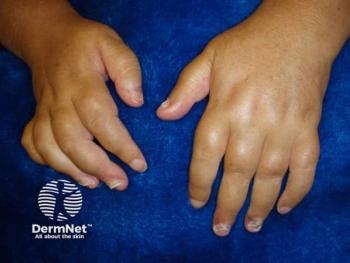
Understanding Flares in Patients With GPP Documented in US Electronic Health Records
Expert dermatologists discuss the methods of a study of US health records of patients with generalized pustular psoriasis.
Episodes in this series

Aaron S. Farberg, MD: We’re always excited when we get approval for various drugs for these diseases because it means that we’re putting in research into exploring the pathophysiology and, most important, developing treatment of these diseases for patients, who we see and want to treat and make better.
Let’s give some background information about generalized pustular psoriasis [GPP]. We know it’s rare. It’s a lifelong skin disease. As we heard from Dr Crowley, there’s the acute phase and then there’s the chronic phase. Every patient is worried and concerned that it might come back. As you see, it’s associated with these intermittent flares. You never know when they’ll hit.
Patients with GPP have been noted to incur considerable health care utilization. They go through a variety of costs and a lot of comorbidity burden compared with patients with plaque psoriasis or the general population. Limited information is known about the prevalence of GPP or GPP flares. Most data come from a single center or even survey-based studies examining small, hospitalized patient samples. This is a rare disease. There weren’t any approved treatments until recently, so we’re just starting to gather all the right data that we need to understand this disease and its pathophysiology.
What was the objective of this study? They wanted to characterize GPP flares and their treatment and to describe the differences between patients with and without documented GPP flares, utilizing our United States EHR [electronic health record] systems, which clinicians know and love. We love EHRs.
What were the methods? This was a retrospective observational cohort study utilizing Optum, deidentified EHR, commercial, Medicare, and Medicaid payers, as well as self-pay data in adults aged 18 or older who had GPP. The search was conducted until December 31, 2019. It was a database search from 2016 to 2019, identifying over 48.6 million patients, with EHR notes available. Of those, 1535 had obtained a GPP diagnosis. Can you imagine being the dermatology fellow who had to go through 48 million patient charts? Thank goodness we have computers. The index GPP diagnosis is the first GPP occurrence from 2016 to 2019, with no other GPP diagnosis in the previous 6 months. That’s how you know that was the start of the index case. GPP patient records with 12 months of health care activity or notes were included, so we have real follow-up. These aren’t just one-offs.
Flare episodes were defined as consecutive days with documented EHR flares. This was documented in the health record. They were characterized by the frequency of occurrence per patient, the care setting where the flare was identified, the specialist who was identifying it, and the treatment type.
The database keyword search methodology was natural-language processing, curated through a literature review and clinical expert input, probably from people like Dr Crowley. Some of the key terms that were searched were rash or erythema, pustular or lesion, GPP symptoms, flares, and clinically relevant synonyms of all those above terms. You’ve got to look for everything. The related visits were defined by the type of clinician or the primary reason for the visit of any skin-related diagnosis, which is the ICD-10 [International Classification of Diseases, 10th revision] code L40.1. Any term for a flare, a pustule, or a lesion was categorized, and any term in the pustular lesion category plus any flare was attributed to it. Dermatology-related visits were defined by the type of clinician and the primary reason for the visit, for any skin-related diagnosis. This included flare, pustule, or lesion as a category or any pustular lesion category, plus any flare attributed to it.
Transcript edited for clarity
Newsletter
Like what you’re reading? Subscribe to Dermatology Times for weekly updates on therapies, innovations, and real-world practice tips.





















